Sternoclavicular Joint
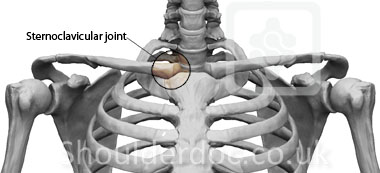
The sternoclavicular joint occurs between the proximal end of the clavicle and the clavicular notch of the manubrium of the sternum together with a small part of the first costal cartilage. The sternoclavicular joint is a saddle-type joint that allows movement of the clavicle, predominantly in anteroposterior and vertical planes, although some rotation also occurs. The ability to thrust the arm and shoulder forward requires sound function of this joint.
Most of the sternoclavicular joint's strength and stability originates from the surrounding joint capsule and is reinforced by four ligaments. The capsule surrounding the joint is weakest inferiorly, while it is reinforced on the superior, anterior and posterior aspects by the various ligaments.
- The anterior and posterior sternoclavicular ligaments are found anterior and posterior to the joint
- The interclavicular ligament links the ends of the two clavicles to each other and to the superior surface of the manubrium of the sternum.
- The costoclavicular ligament is positioned laterally to the joint and links the proximal end of the clavicle to the first rib and related costal cartilage
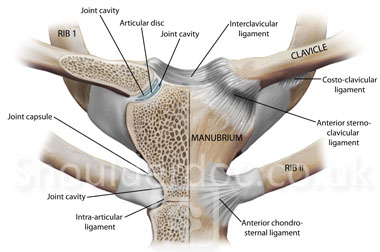
Sternoclavicular joint injuries
Usually only through significant force do the ligaments supporting the sternoclavicular joint become completely disrupted, enabling dislocation of the joint. The extent of the damage to the supporting ligaments and capsule dictates whether the joint subluxes or dislocates. Sternoclavicular joint injuries are graded into three categories.
Anterior dislocations of the joint are much more common (by a 9:1 ratio) usually resulting from an indirect action, such as a blow to the anterior shoulder that rotates the shoulder backwards thereby transmitting the stress to the sternoclavicular joint.
Posterior dislocations of the joint are usually a result of a force driving the shoulder forwards, or from a direct impact to the superior sternal or medial clavicular surfaces. An example of the latter would be falling on a rugby ball with your team mates landing on top of you!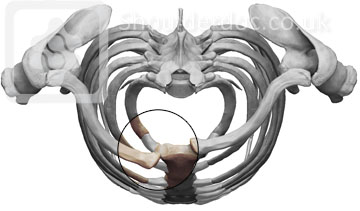
ANTERIOR DISLOCATION (viewed from above)
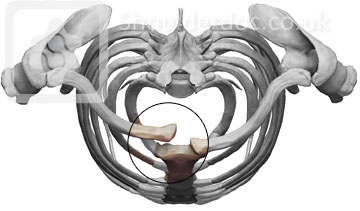
POSTERIOR DISLOCATION (viewed from above)
Usually only through significant force do the ligaments supporting the sternoclavicular joint become completely disrupted, enabling dislocation of the joint. The extent of the damage to the supporting ligaments and capsule dictates whether the joint subluxes or dislocates. Sternoclavicular joint injuries are graded into three categories.
- First degree injury: a simple sprain, which involves an incomplete tear or stretching of the sternoclavicular and costoclavicular ligaments. This is the most common type of sternoclavicular joint injury.
- Second degree injury: the clavicle subluxes either anteriorly or posteriorly from its manubrial attachment, causing a complete breach of the sternoclavicular ligament but at most, only a partial tear of the costoclavicular ligament
- Third degree injury: a complete rupture of the sternoclavicular and costoclavicular ligaments, permitting a complete dislocation of the clavicle from the manubrium.
Anterior dislocations of the joint are much more common (by a 9:1 ratio) usually resulting from an indirect action, such as a blow to the anterior shoulder that rotates the shoulder backwards thereby transmitting the stress to the sternoclavicular joint.
Posterior dislocations of the joint are usually a result of a force driving the shoulder forwards, or from a direct impact to the superior sternal or medial clavicular surfaces. An example of the latter would be falling on a rugby ball with your team mates landing on top of you!

ANTERIOR DISLOCATION (viewed from above)

POSTERIOR DISLOCATION (viewed from above)
Sternoclavicular joint arthritis
Osteoarthritis is a degenerative arthritis that tends to get worse with age. Injury to this joint can in some cases, develop into osteoarthritis, which can cause pain and stiffness. Osteoarthritis is normally treated with rest, physiotherapy and anti-inflammatory medications. If the symptoms of osteoarthritis do not respond to this cause of treatment then surgery may be needed.
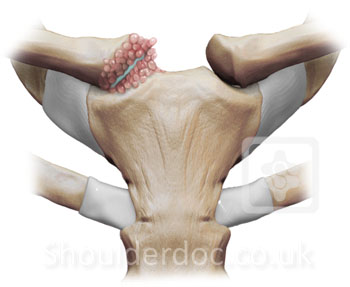
Sternoclavicular joint arthritis
Osteoarthritis is a degenerative arthritis that tends to get worse with age. Injury to this joint can in some cases, develop into osteoarthritis, which can cause pain and stiffness. Osteoarthritis is normally treated with rest, physiotherapy and anti-inflammatory medications. If the symptoms of osteoarthritis do not respond to this cause of treatment then surgery may be needed.

Sternoclavicular joint arthritis


